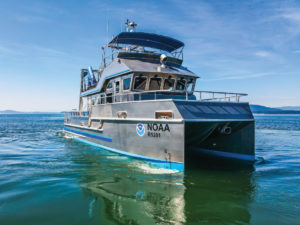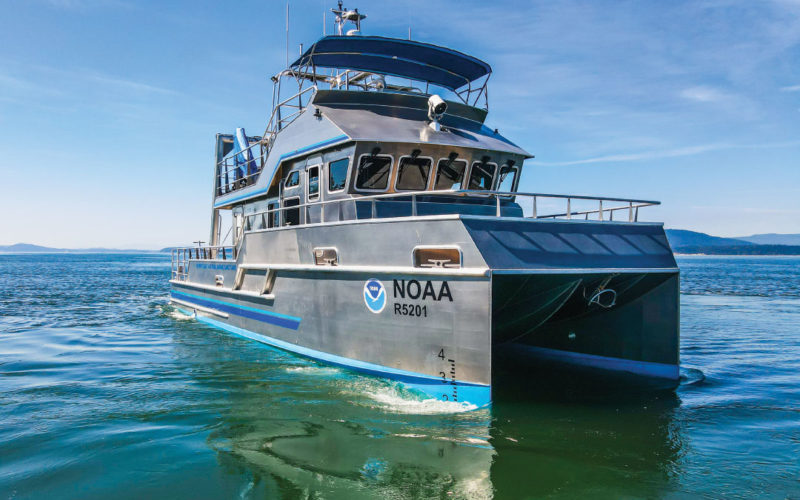
A new fuel-efficient aluminum boat that’s built to handle heavy loads of scientific equipment is helping researchers understand the future of the world’s oceans.
The 50-foot aluminum catamaran Storm Petrel is a platform for studying ocean acidification and other changes on the wild shores of Washington state, a place teeming with whales and other sea life.
Nic de Waal, managing director of Teknicraft Design in New Zealand, designed Storm Petrel, and All American Marine in Bellingham, Wash., built the vessel. It was delivered in August to the National Oceanic and Atmospheric Administration (NOAA), which operates it from La Push, Wash., on the Olympic Peninsula.
Storm Petrel’s primary mission is to maintain a series of floating buoys that measure water temperature, acidity and other data. In a typical maintenance mission, researchers haul a buoy onto the boat and download the data. From there, they upload the information to the internet, making it available to researchers around the world.
The new boat is bigger and better than the one it’s replacing, said NOAA’s Kevin Grant, and it helps the agency complete missions in partnership with universities, nonprofits and state, federal and tribal governments.
“We have been working on acquiring a new vessel that would fit our needs for almost a decade,” said Grant, the deputy sanctuary superintendent with the Olympic Coast National Marine Sanctuary where the boat is currently operating.
The boat’s lead captain is Marshall Stein, a former U.S. Coast Guard captain who came to Washington in July specifically to pilot this boat, Grant said. The vessel is fitted with twin Cummins QSC8.3 engines driving conventional propellers.
In a typical mission, NOAA needs the boat to cruise at 18 knots. These engines can reach that speed with just 50 percent power, said Ron Wille, president and chief operating officer for All American Marine.
“The engine application was a great fit, and it will last NOAA a very long time,” he said.
Wille also pointed to another important design aspect: the boat’s plumb bow.
“The bow is vertical, straight up and down. And that basically gives the boat some additional length at the waterline, which generates higher hull efficiency at slower speeds,” he said.
De Waal, of Teknicraft, provided more details on how the hull design contributes to the boat’s mission.
“NOAA’s mission requirement for the vessel is to be able to operate up to 100 nautical miles off the coast of Washington state,” he wrote in an email. “Within the constraint of a maximum allowable vessel length of 52 feet, we designed the hull to provide the best possible seakeeping in offshore conditions, whilst also having low resistance to ensure long range, and have the stability and course-keeping ability required to accurately and efficiently perform survey work.”
Storm Petrel is also designed for a heavy load. The vessel carries a wide range of scientific equipment and a load of up to 8,000 pounds. As such, de Waal said, “the hull shape was carefully designed to support this displacement whilst still providing speed of up to 25 knots.”
Fuel consumption averages about 1.3 gallons per nautical mile at 20 knots during a typical mission, he said. The vessel also has a wave piercer between the catamaran sponsons to break up wave action and reduce drag.
Storm Petrel replaces the 41-foot monohull Tatoosh, which was built in 1994. It is shorter and narrower than Storm Petrel, Grant said, and it carries fewer people.
The new vessel can carry up to 18 people and is primarily designed for day trips from its home port into the Olympic Coast National Marine Sanctuary — an area of about 3,188 square miles of ocean off the rugged Olympic Peninsula. The sanctuary runs 25 to 50 miles offshore and contains several submarine canyons, Grant said.
“But it’s an extremely important ecosystem in that those canyons during the summertime funnel cooler, deeper waters that are nutrient-rich up onto the continental shelf,” he added. “And that’s why we get plankton blooms, which result in large whale migrations coming through here at certain times.”
“Large seabird populations, numerous different types of whales, seals, sea lions, sea otters” also populate the area, he continued. “It’s quite an astonishing ecosystem.”
As humans burn fossil fuels, the world’s oceans are absorbing increased amounts of carbon dioxide. That, in turn, increases the acidity of the water.
Grant explained how ocean acidification can impact species off the waters of Washington, starting with the tiny creatures called pteropods that feed young salmon that have just reached the ocean. Less than one centimeter long, they look something like a snail with wings; the Monterey Bay Aquarium calls them “swimming snails of the sea.”
“The increasingly acidic water prevents them from forming their shell,” Grant said. “Quite literally, their shell dissolves. And when that happens, the organism dies, there’s less food for salmon, less salmon available for humans, and less for the southern resident killer whales that feed almost exclusively on salmon.”
“Ocean acidification has traumatic impacts up and down the marine food chain,” he added.
NOAA has said the damage to marine species could harm economies and destroy jobs. Grant considers Washington an important spot to monitor the ocean acidification process.
“Not only is it already happening, but the west coast of Washington is almost the canary in the coal mine.”
To haul buoys and other pieces of scientific equipment on board, Storm Petrel is equipped with an A-frame, an InterOcean winch and a Morgan crane. It also has a “pot puller” designed for pulling crab pots from the seafloor. The lifting equipment can also deploy and recover remote-control submarines, Grant said.
The boat’s lifting capacity is far superior to that of its predecessor. While Tatoosh could lift 500 pounds, the A-frame on Storm Petrel can handle 10 times that much weight.
A flybridge with a bimini top gives researchers a good vantage point for observing wildlife. The vessel also has dive ladders to support underwater operations.
The crew working on the boat have accommodations including a galley and dinette. The vessel is large enough to bring some passengers on board for education and outreach purposes as well.
A university or other partner can bring a specific piece of equipment to the boat deck, fasten it down and connect it to three dry lab computer workstations, Grant said. Computer server racks on the vessel are equipped with backup power in case of a power failure. The vessel also has a wet lab space for examining specimens.
All American’s Wille said the boat’s builders squeezed a lot of features into a relatively small space. Doing so meant using space wisely. The best example is how the team put together the engine room, fitting in the hydraulics, generator power, exhaust systems and the engines themselves.
“It’s a lot of equipment to fit in a small space, but our team did an exemplary job of accomplishing that,” Wille said. “The boat really turned out wonderful. We’re very, very proud of it.”
Grant acknowledged it took the agency a long time to obtain a new boat for this stretch of western Washington. Storm Petrel should end up being worth the wait.
“We are thrilled,” he said, “to finally have an on-the-water asset that will allow our research programs to grow and serve as a very sound platform for partners.” •

